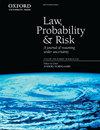Treatment of inconclusives in the AFTE range of conclusions
IF 1.4
4区 社会学
Q1 LAW
引用次数: 14
Abstract
In the past decade, and in response to the recommendations set forth by the National Research Council Committee on Identifying the Needs of the Forensic Sciences Community (2009), scientists have conducted several black-box studies that attempt to estimate the error rates of firearm examiners. Most of these studies have resulted in vanishingly small error rates, and at least one of them (D. P. Baldwin, S. J. Bajic, M. Morris, and D. Zamzow. A Study of False-Positive and False-Negative Error Rates in Cartridge Case Comparisons. Technical report, Ames Lab IA, Performing, Fort Belvoir, VA, April 2014.) was cited by the President’s Council of Advisors in Science and Technology (PCAST) during the Obama administration, as an example of a well-designed experiment. What has received little attention, however, is the actual calculation of error rates and in particular, the effect of inconclusive findings on those error estimates. The treatment of inconclusives in the assessment of errors has far-reaching implications in the legal system. Here, we revisit several black-box studies in the area of firearms examination, investigating their treatment of inconclusive results. It is clear that there are stark differences in the rate of inconclusive results in regions with different norms for training and reporting conclusions. More surprisingly, the rate of inconclusive decisions for materials from different sources is notably higher than the rate of inconclusive decisions for same-source materials in some regions. To mitigate the effects of this difference we propose a unifying approach to the calculation of error rates that is directly applicable in forensic laboratories and in legal settings.AFTE结论范围内的非闭合性治疗
在过去的十年里,为了响应国家研究委员会确定法医科学界需求委员会(2009年)提出的建议,科学家们进行了几项黑匣子研究,试图估计枪支检查员的错误率。这些研究中的大多数都导致了极小的错误率,其中至少有一项(D.P.Baldwin、S.J.Bajic、M.Morris和D。赞佐。弹壳比较中假阳性和假阴性错误率的研究。技术报告,Ames Lab IA,Performing,Fort Belvoir,VA,2014年4月。)被奥巴马政府时期的总统科学技术顾问委员会(PCAST)引用为一个精心设计的实验的例子。然而,很少受到关注的是误差率的实际计算,特别是不确定的调查结果对这些误差估计的影响。在评估错误时对不确定因素的处理在法律体系中具有深远的影响。在这里,我们回顾了枪支检查领域的几项黑匣子研究,调查了它们对不确定结果的处理。很明显,在培训和报告结论规范不同的区域,不确定结果的发生率存在明显差异。更令人惊讶的是,在一些地区,来自不同来源的材料的非决定性决策率明显高于同一来源材料的非确定性决策率。为了减轻这种差异的影响,我们提出了一种统一的错误率计算方法,该方法直接适用于法医实验室和法律环境。
本文章由计算机程序翻译,如有差异,请以英文原文为准。
求助全文
约1分钟内获得全文
求助全文
来源期刊

Law Probability & Risk
MATHEMATICSSTATISTICS & PROBABILITY&-STATISTICS & PROBABILITY
CiteScore
2.10
自引率
28.60%
发文量
8
期刊介绍:
Law, Probability & Risk is a fully refereed journal which publishes papers dealing with topics on the interface of law and probabilistic reasoning. These are interpreted broadly to include aspects relevant to the interpretation of scientific evidence, the assessment of uncertainty and the assessment of risk. The readership includes academic lawyers, mathematicians, statisticians and social scientists with interests in quantitative reasoning.
The primary objective of the journal is to cover issues in law, which have a scientific element, with an emphasis on statistical and probabilistic issues and the assessment of risk.
Examples of topics which may be covered include communications law, computers and the law, environmental law, law and medicine, regulatory law for science and technology, identification problems (such as DNA but including other materials), sampling issues (drugs, computer pornography, fraud), offender profiling, credit scoring, risk assessment, the role of statistics and probability in drafting legislation, the assessment of competing theories of evidence (possibly with a view to forming an optimal combination of them). In addition, a whole new area is emerging in the application of computers to medicine and other safety-critical areas. New legislation is required to define the responsibility of computer experts who develop software for tackling these safety-critical problems.
 求助内容:
求助内容: 应助结果提醒方式:
应助结果提醒方式:


